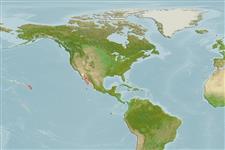>
Blenniiformes (Blennies) >
Chaenopsidae (Pike-, tube- and flagblennies)
Etymology: Coralliozetus: Greek, korallion = coral + Greek, ketos = a marine monster, whale (Ref. 45335).
Environment: milieu / climate zone / depth range / distribution range
Écologie
marin récifal; profondeur 1 - 4 m (Ref. 11482). Tropical
Eastern Central Pacific: Baja California, Mexico and the Gulf of California.
Taille / Poids / Âge
Maturity: Lm ? range ? - ? cm
Max length : 3.5 cm TL mâle / non sexé; (Ref. 11482)
Inhabits empty mollusk tubes on rocky reefs. Feeds on zooplankton.
Life cycle and mating behavior
Maturities | Reproduction | Spawnings | Egg(s) | Fecundities | Larves
Allen, G.R. and D.R. Robertson, 1994. Fishes of the tropical eastern Pacific. University of Hawaii Press, Honolulu. 332 p. (Ref. 11482)
Statut dans la liste rouge de l'IUCN (Ref. 130435)
Menace pour l'homme
Harmless
Utilisations par l'homme
Outils
Articles particuliers
Télécharger en XML
Sources Internet
Estimates based on models
Preferred temperature (Ref.
123201): 22.3 - 28.7, mean 25.3 °C (based on 191 cells).
Phylogenetic diversity index (Ref.
82804): PD
50 = 0.5156 [Uniqueness, from 0.5 = low to 2.0 = high].
Bayesian length-weight: a=0.00457 (0.00183 - 0.01143), b=3.08 (2.86 - 3.30), in cm total length, based on LWR estimates for this (Sub)family-body shape (Ref.
93245).
Niveau trophique (Ref.
69278): 3.4 ±0.45 se; based on food items.
Fishing Vulnerability (Ref.
59153): Low vulnerability (10 of 100).
Nutrients (Ref.
124155): Calcium = 248 [113, 547] mg/100g; Iron = 0.992 [0.511, 1.886] mg/100g; Protein = 18 [17, 19] %; Omega3 = 0.097 [0.043, 0.210] g/100g; Selenium = 11.7 [4.5, 32.7] μg/100g; VitaminA = 524 [136, 1,994] μg/100g; Zinc = 2.66 [1.59, 4.27] mg/100g (wet weight);
